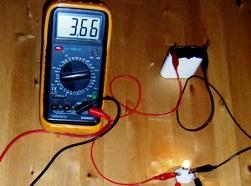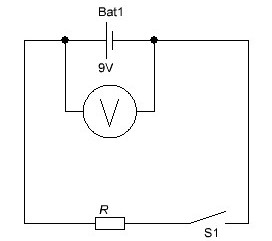Categories: Featured Articles » Novice electricians
Number of views: 21068
Comments on the article: 0
Electrical measurements
What is an electrical circuit?
 Any electrical circuit consists of a source and a receiver of electrical energy, interconnected by wires. What is a wire, it is understandable, but as a receiver and source can be any combination of various devices. The general case of the simplest electrical circuit is shown in Figure 1.
Any electrical circuit consists of a source and a receiver of electrical energy, interconnected by wires. What is a wire, it is understandable, but as a receiver and source can be any combination of various devices. The general case of the simplest electrical circuit is shown in Figure 1.
The source of electrical energy can be a conventional battery or a powerful transformer substation. The energy receiver shown in the figure is also the most diverse - from a flashlight for a flashlight to an apartment building. Connecting wires will also correspond to power consumption. Further, only low-power sources and receivers will be considered not more powerful than the mentioned light bulb.
For a power source, the receiver is a load. That is what it is most often called. Further in the article, resistors, in some cases light bulbs, will be used as a load.

Figure 1. The simplest electrical circuit
The electrical circuit must be closed.
At the household level, electric current is everything that is connected with electricity. There is a socket on the wall, and an electric current lives in it! This is actually a bit wrong. And while nothing is plugged in, there is no current. There is voltage, but no current!
Electric current flows only in a closed circuit. If galvanic battery, or simply a battery, lies on a table and voltage is not connected anywhere on its terminals. In this state, the voltage is called the electromotive force (EMF) of the source. In the formulas and schemes EMF is indicated by the letter E.
Ohm's law for the whole chain
When a load is connected to the battery, the voltage drops somewhat, due to a voltage drop on the internal resistance of the source, in this case the battery. This fall is taken into account in Ohm's law for the entire chain (see: Ohm's law in a popular statement) The circuit itself is shown in Figure 2.
I = E / (R + r)
The expression in parentheses is the total resistance of the circuit, obtained as the sum of the load resistance and the internal resistance of the battery, indicated by a small letter.

Figure 2
In another way, this mathematical expression is written as follows: E = I * (R + r) = I * R + I * r
Usually the product of the current by the resistance is called the voltage drop in the circuit. In this case, the second term in the formula is the voltage drop across the internal resistance of the battery. It is by this value that the EMF of the battery is reduced.
As the battery discharges, its internal resistance grows and, in the end, becomes so large that when the load is connected, the entire EMF is consumed to overcome its own resistance. And the voltage at the output terminals becomes very small, it is already impossible to transfer energy to an external circuit. In such cases, they say that the battery has run out.
To verify what has been said, you can assemble the simplest circuit shown in Figure 3.

Figure 3
Yes, actually, there is no need to collect anything. Just connect a voltmeter to the battery, and then simply apply load resistance with your hands. To test Krona batteries, a 100 Ohm resistor is recommended as the load. The voltmeter will drop slightly, depending on the internal resistance of the battery. If during such a test the voltmeter shows a voltage below 7 volts, then the Krona must be replaced.
The same thing happens in apartment wiring. It is enough to connect an iron, fireplace or other powerful load, as the brightness of the lamps in the chandelier is slightly reduced. This clearly indicates that there was a voltage drop on the wires.It is the resistance of the wires in this case that is the internal resistance of the source of electricity.
As a rule, they don’t stand on ceremony with galvanic cells of the “fingers - little fingers” type: they simply take and check for a short circuit current, turning the multimeter into current measurement mode. If the element is still alive, it gives a current of several hundred milliamps, and a fresh element can give up to 3 ... 5 amperes.
In no case should such a test be carried out with batteries that look like galvanic cells. Their device is completely different, and the price is much higher.
A universal instrument for measuring electrical circuits is a multimeter. Read how to use it privately here: "A multimeter for" dummies ": the basic principles of measuring with a multimeter".
See also: Voltage measurement and Current measurement
See also at bgv.electricianexp.com
:
